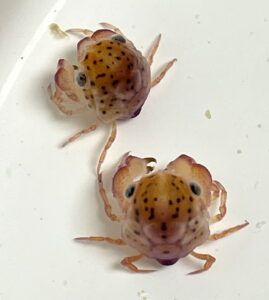
I carried a handful of these baby crabs home in a bag of seawater to photograph. These two megalops were walking about my dish with their tails tucked below. Megalops is the name of the life stage most crabs go through immediately before they molt into their adult form. ©Susan Scott
August 20, 2023
When thousands of pea-sized crabs washed up on Oahu’s shorelines on August 5th, the creatures had us beach walkers puzzled. We longtime residents could not remember seeing an influx of this kind.
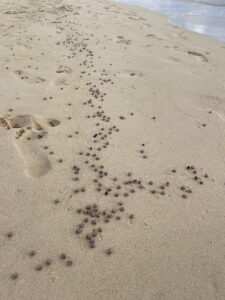
Baby crabs washed ashore on Lanikai Beach, August 5, 2023. ©Susan Scott
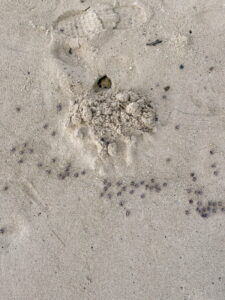
The beached megalops were a feast for ghost crabs, the great recyclers that dig holes (shown above) nightly in our sandy beaches. ©Susan Scott
The first one I picked up during an early morning stroll on Lanikai Beach was so tightly rolled up I thought it was a seed blown into the water by strong winds. But I soon saw that some of those “seeds” in the long lines were trying to walk.
After holding a few in my palm, I recognized the creatures as tiny crabs in their last larval stage of growth called a megalops. The term megalops is ancient Greek meaning large eyes.
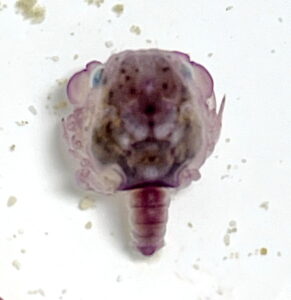
During this immature form of life, the developing crab’s rear appendage looks like a tail, and the baby has large, and in this case, blue, eyes. ©Susan Scott
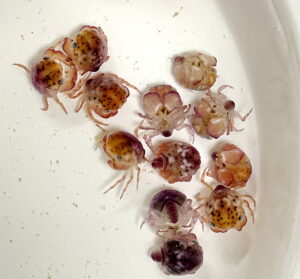
This shows the megalops I brought home in various stages of life and death. ©Susan Scott
Megalops are a normal part of the oceans’ drifting animal life called zooplankton, and cannot live for long on land. Several of us launched handfuls of the youngsters back to the water, but hundreds of thousands stranded on the sand did not survive. That doesn’t necessarily mean there will be a shortage of 7-11 crabs on our reefs. Female spotted crabs can lay from thousands to millions of eggs with each spawn. Check out this amazing post: spawning spotted reef crab.
As to the identity of the recent megalops influx, Andrew Rossiter, the director of the Waikiki Aquarium, said in a Hawaiʻi News Now report that the immature crabs are probably what we in Hawaiʻi call 7-11 crabs. His guess was that offshore hurricane winds blew the drifting baby crabs ashore.
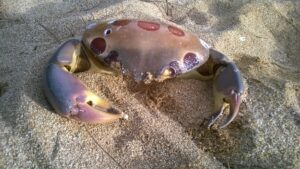
In August of 2014, reader Bill Quinlan sent me this picture of a dead 7-11 crab he found on a North Shore Oahu beach. ©Bill Quinlan
The Hawaiian name for this reef crab species, found throughout the Indian and Pacific Oceans, is ʻalakuma. In other parts of the world, people call them spotted crabs. The scientific name is Carpilius maculatus. The species grows to about six inches across the widest part of its shell.
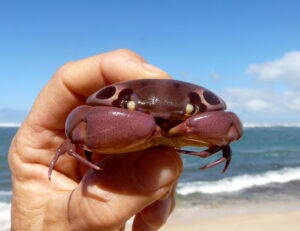
I found this healthy young 7-11 crab on a Waialua reef during low tide. ©Susan Scott
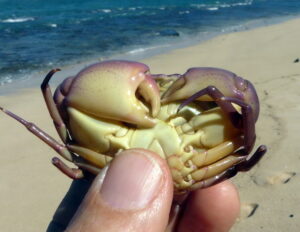
The underside of my live 7-11 crab. After photographing, I returned it to its reef hole. ©Susan Scott
A common story about the unusual Hawaiʻi name for this crab is that it refers to the creatures’ maroon spots. Although some individuals have more than 11 spots, most individuals have seven spots across the shell’s front and top, and four across the lower back, totaling 11.
That logic would make it this a 7-4 crab, but seven-eleven has a better beat. A 1940s convenience store chain called Tot’m liked the rhyming words as well. In 1946 the company changed its name to 7-Eleven to reflect its long operating hours, 7 A.M. to 11 P.M.
Those of us who say we’ve never seen such a stranding before have short memories. An Internet search shows a Hawaiʻi News Now report of a similar mass arrival on July 16, 2012. And although I don’t remember taking those pictures, the photo credits in that report say Susan Scott.
So, OK, we have indeed seen these little gems on our beaches before. I may have even talked to a TV reporter about them in 2012 because in 2014, I mentioned the event in my newspaper column. Oh, well. No one I talked to this month remembered it either.
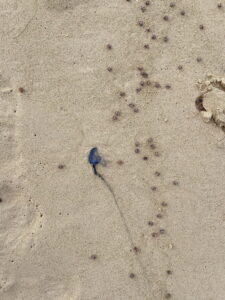
Crabs are crackerjack beach cleaners. Mole crabs that live below the sand’s surface at the waterline will soon eat this Portuguese man-of-war. Ghost crabs eat everything else, plant and animal, dead or dying. ©Susan Scott